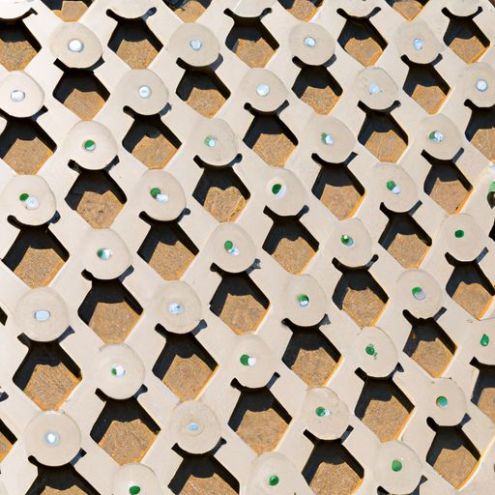Table of Contents
قدرة تحمل النقطة للشبكة الجغرافية البلاستيكية الفولاذية
بالإضافة إلى المواد المستخدمة في بنائها، يلعب تصميم الشبكة الجغرافية البلاستيكية الفولاذية أيضًا دورًا حاسمًا في تحديد قدرتها على تحمل النقاط. إن التباعد واتجاه الأسلاك الفولاذية في الشبكة الجغرافية، وكذلك سمك طبقة البوليمر، كلها تؤثر على قدرة الشبكة الجغرافية على توزيع الأحمال بالتساوي ومقاومة التشوه. يعد التثبيت الصحيح للشبكة الجغرافية، بما في ذلك التأكد من تثبيتها بشكل آمن على التربة وأن أي طبقات متداخلة وملحومة بشكل صحيح، ضروريًا أيضًا لزيادة قدرة تحمل النقطة إلى أقصى حد.
إحدى المزايا الرئيسية للشبكات الجغرافية البلاستيكية الفولاذية هي ارتفاعها مقاومة الشيخوخة والعوامل البيئية. يساعد طلاء البوليمر الموجود على الأسلاك الفولاذية على حمايتها من التآكل، والأشعة فوق البنفسجية، وغيرها من أشكال التدهور، مما يضمن احتفاظ الشبكة الجغرافية بقوتها وصلابتها بمرور الوقت. تعتبر هذه المقاومة للشيخوخة مهمة بشكل خاص في التطبيقات التي تتعرض فيها الشبكة الجغرافية لظروف بيئية قاسية، كما هو الحال في بناء الطرق أو تصميم مدافن النفايات.
من الخصائص المهمة الأخرى للشبكات الجغرافية الفولاذية والبلاستيكية قوة الفصل العالية للمفاصل، والتي تشير إلى قدرة الشبكة الجغرافية على مقاومة الحركة الجانبية والحفاظ على سلامتها عند تعرضها لقوى القص. تعتبر هذه الخاصية حاسمة في التطبيقات التي يتم فيها استخدام الشبكة الجغرافية لتثبيت المنحدرات أو السدود، لأنها تساعد على منع تآكل التربة وفشل المنحدرات. يتم تحقيق قوة الفصل العالية لمفاصل الشبكات الجغرافية البلاستيكية الفولاذية من خلال الجمع بين قوة الشد العالية للأسلاك الفولاذية ومقاومة الاحتكاك لطلاء البوليمر، والتي تعمل معًا لتثبيت التربة في مكانها ومنعها من الانزلاق أو الانهيار.
في الختام، فإن قدرة تحمل النقطة وقوة الفصل العالية لمفاصل الشبكات الجغرافية البلاستيكية الفولاذية تجعلها خيارًا مثاليًا لمجموعة واسعة من تطبيقات الهندسة المدنية. وتضمن قوتها الشد العالية وصلابتها ومقاومتها للشيخوخة والعوامل البيئية قدرتها على تحمل الأحمال الثقيلة والظروف القاسية، في حين أن قدرتها على مقاومة الحركة الجانبية والحفاظ على سلامتها تحت قوى القص تجعلها حلاً فعالاً لتثبيت التربة وتعزيزها. من خلال فهم الخصائص الرئيسية للشبكات الجغرافية الفولاذية البلاستيكية وكيفية مساهمتها في أدائها، يمكن للمهندسين والمصممين اتخاذ قرارات مستنيرة بشأن استخدام هذه المواد في مشاريعهم.

In addition to the materials used in its construction, the design of a steel plastic geogrid also plays a crucial role in determining its point bearing capacity. The spacing and orientation of the steel wires in the geogrid, as well as the thickness of the Polymer coating, all affect the geogrid’s ability to distribute loads evenly and resist deformation. Proper installation of the geogrid, including ensuring that it is securely anchored to the soil and that any seams are properly overlapped and welded, is also essential for maximizing its point bearing capacity.
One of the key advantages of steel plastic Geogrids is their high resistance to aging and environmental factors. The polymer coating on the steel wires helps to protect them from corrosion, UV radiation, and other forms of degradation, ensuring that the geogrid maintains its strength and stiffness over time. This resistance to aging is particularly important in applications where the geogrid will be exposed to harsh environmental conditions, such as in road construction or landfill design.
Another important property of steel plastic geogrids is their high separation force of joint, which refers to the ability of the geogrid to resist lateral movement and maintain its integrity when subjected to shear forces. This property is crucial in applications where the geogrid is used to stabilize slopes or embankments, as it helps to prevent soil erosion and slope failure. The high separation force of joint of steel plastic geogrids is achieved through the combination of the high tensile strength of the steel wires and the frictional resistance of the polymer coating, which work together to hold the soil in place and prevent it from sliding or collapsing.
In conclusion, the point bearing capacity and high separation force of joint of steel plastic geogrids make them an ideal choice for a wide range of civil engineering applications. Their high tensile strength, stiffness, and resistance to aging and environmental factors ensure that they can withstand heavy loads and harsh conditions, while their ability to resist lateral movement and maintain their integrity under shear forces makes them an effective solution for soil stabilization and reinforcement. By understanding the key properties of steel plastic geogrids and how they contribute to their performance, engineers and designers can make informed decisions about the use of these materials in their projects.

